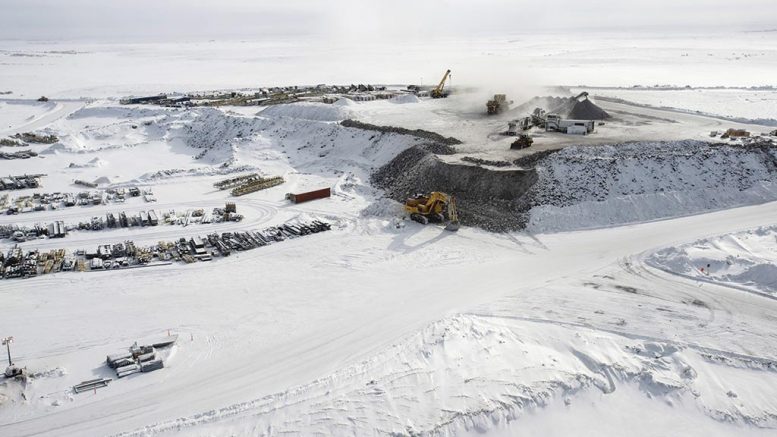VANCOUVER — It’s been 25 years since diamonds were found in the Northwest Territories (NWT) at Lac de Gras, and Hendrik Falck, mineral deposits geologist from the Northwest Territories Geoscience office, says the precious stone is still the most sought-after commodity in the region.
“The big news for us last year was the opening of the Gahcho Kué mine replacing Snap Lake as our third diamond mine, and that was huge for us,” Falck tells The Northern Miner during a phone interview.
De Beers and 49% joint-venture partner Mountain Province Diamonds (TSX: MPVD; NASDAQ: MVPD) opened the Gahcho Kué mine in September 2016, almost a year after De Beers placed its troubled Snap Lake underground diamond mine on care and maintenance, laying off 434 employees.
In January, the company had planned to flood Snap Lake, which failed to turn a profit since the operation opened in 2008.
Gahcho Kué meanwhile, is ramping up to full production. The $1-billion, open-pit mine is scheduled to deliver an average 4.5 million carats a year on a 100% basis over a 12-year mine life, making it the company’s second-largest mine behind Jwaneng in Botswana, which produced 9.8 million carats in 2015.
Falck notes that Gahcho Kué, at full capacity, could provide more than 2,700 jobs — including supply and service chain employment — and inject $6.7 billion into the Canadian economy.
In January, Mountain Province reported on its first diamond sale, with 49,420 carats sold for US$6.27 million, or US$127 per carat.
In February the mine recovered a 67.87-carat, gem-quality octahedron diamond.
The remaining diamond production in the territory comes from Dominion Diamonds’ (TSX: DDC; NYSE: DDC) Ekati mine and Rio Tinto (NYSE: RIO; LON: RIO) and Dominion’s Diavik mines, both of which are being expanded.
According to company updates, development of Diavik’s A-21 pipe, located below Lac de Gras, is progressing as planned, with production scheduled to begin in 2018. The pipe’s reserves of 3.6 million tonnes of 2.8 carats per tonne for 10 million carats would provide an incremental supply for Diavik, ensuring production until 2023.
At Ekati, the partners have received environmental approval to add the Jay kimberlite pipe to its mine plan, which could extend the mine life by 10 years to 2034. The pipe hosts 48.1 million tonnes of 1.9 carats per tonne, for 89.9 million carats.

Rough diamonds extracted from Dominion Diamond’s Ekati mine in the Northwest Territories. Credit: Dominion Diamond.
Falck points out that diamonds accounted for 97% of the $1.8 billion made from mineral production in the NWT in 2015. And while exploration spending is still low compared to the peak of the diamond rush a quarter century ago, the territory has seen an encouraging rise in activity of late.
“As an office, we’ve been active with till sampling and Quaternary mapping programs across the central Slave province, and that has given us a much stronger understanding of the glacial history of the region, which helps with the exploration for kimberlites,” Falck says. “The first pass for diamond exploration was done quickly, but now there are a lot of companies taking a second look at older plays … and there’s been success as a consequence of that.”
One such example is Kennady Diamonds’ (TSXV: KDI; US-OTC: KDIAF) Kennady North project, 5 km from the Gahcho Kué mine. In December last year, the company announced a maiden indicated resource of 8.5 million tonnes of 1.6 carats per tonne for 13.6 million carats at the project’s key Kelvin kimberlite.
For comparison, Gahcho Kué hosts probable reserves of 35.4 million tonnes grading 1.57 carats per tonne for 55.5 million carats.
While diamonds still attract the most attention in the NWT, Falck points out a number of precious and base metal projects that are gaining traction amongst explorers.
TerraX Minerals’ Yellowknife City gold project outside of Yellowknife, and Nighthawk Gold’s (TSXV: NHK; US-OTC: MIMZF) Colomac gold property, 200 km north of Yellowknife, both involve exploration for Archean-age gold deposits in greenstone belts like those found in Ontario and Quebec.
Latest drill results from TerraX at its Sam Otto zone has extended the gold mineralization for at least 350 metres of strike and 250 metres deep, with 30- to 50-metre-wide zones greater than 1 gram gold per tonne.
At Indin Lake, Nighthawk is expanding the resource at the project’s Goldcrest deposit and testing more mineralized zones. The company has outlined 39.8 million tonnes of 1.64 grams gold for 2.1 million oz. gold across a number of deposits on the property to date.
However, an anticipated 97 km, all-season road to the remote community of Whati, 166 km northwest of Yellowknife, could give a boost to Fortune Minerals’ (TSX: FT) Nico gold-cobalt-bismuth-copper project. The federal government announced in January that it would pay 25% of the cost of building the road, with more funding from the territorial government and private sector, pending approval by the legislative assembly.
Fortune has struggled to secure financing for the $589-million project in recent years. The project requires the concentrate to be shipped out and processed at the company’s proposed refinery near Saskatoon, Saskatchewan.
“The road would open up other parts of the Southern Bear province, and allow explorers to revisit a number of known deposits there,” Falck says.
Other advanced projects in the NWT include Canadian Zinc’s (TSX: CZN) Prairie Creek lead-silver-zinc property, 500 km west of Yellowknife in the Mackenzie Mountains, and Selwyn Chihong Mining’s Howard’s Pass zinc-lead project that straddles the border with the Yukon Territory.


Be the first to comment on "Diamonds add sparkle to NWT’s economy"